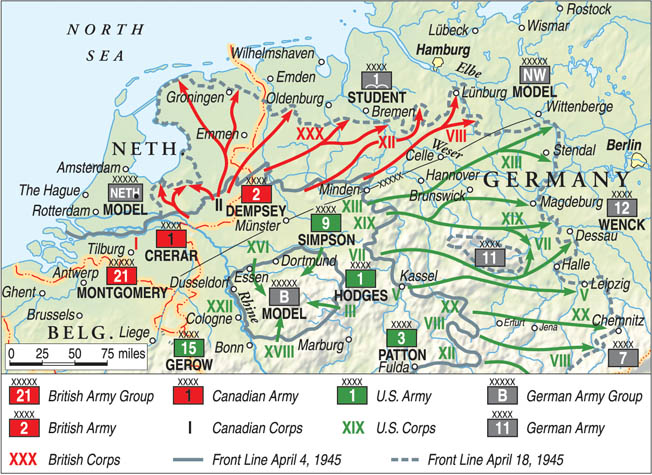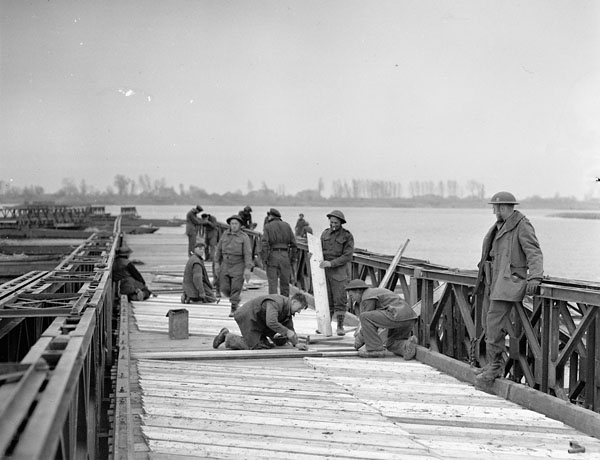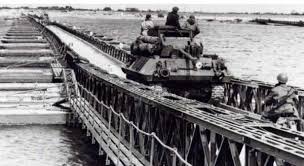In March 1945 the Allies were on the road to victory. Field Marshall Montgomery needed First Canadian Army to open a supply route through Arnhem to feed supplies to Twenty-First Army Group during its northward advance to the Elbe. Once this route was secure, the Canadians were to “operate to clear Northeast Holland, the coast belt [of Germany] eastwards to the Elbe, and West Holland [if necessary].” Meanwhile, once the British Second Army gained the Elbe, it would cease advancing and swing whatever forces to the west were required to “assist Canadian Army in its task of clearing the coastal belt".
On March 28, the Canadians crossed the Rhine at Rees and moved into their bridgehead. The move was made possible by the remarkable noon opening of Blackfriars Bridge. At 1,8I4(1) feet, it was the longest Bailey bridge built in Northwest Europe. It was designed to carry Military Load Class 40 vehicles, which included the tanks of the time. The 34 m (110 ft) landing bays were constructed to Military Load Class 70 standard and the end floating bays were reinforced to provide extra strength. The full floating section comprised 34 connected spans of 42-foot length and one span of 32-foot length. Construction of 825 yards (754 metres) of new road was started immediately.
Construction of the ‘home bank’ had been assigned to the 30th Field Company while the far bank was the responsibility of the 29th Field Company. 31st Field Company was tasked with the construction of the floating bays. Each company was augmented by British pioneers. Bridge construction began mid-day on 26 March and was delayed due to slow delivery of stores and heavy fog. Nonetheless. the bridge was finished a full 48 hours ahead of schedule. All-told, some 227 truck-loads of bridging stores were man-handled and some 9500 man-hours were employed in constructing the bridge. At 1803 feet total length, it was identified as the longest Bailey Bridge at the time.
The officer in charge of the construction of Blackfriars Bridge was Lt. William Fernley "Bill" Brundrit from the 30th Field Company. Lt. Brundrit was awarded the Military Cross for his courage and leadership on this bridging project - from the earliest reconnaissance until completion of the task. Bill was born in Scarborough, Ontario, one of four children. He died on 15 February 1991, at the age of 74 and was buried in Weston, Ontario
Notes:
1. A message from the C.R.E. (Lieut.-Colonel V. C. Hamilton) to the formation on 5th May, 1945, gives the length of this bridge as 1803 feet, "the longest Bailey bridge in the world."
2. Lt Brundit's brother, Sgt EH Brundit, served in the Royal Canadian Dragoons in Sicily and Italy and later Northwest Europe where he was killed on 4 May 1945.
During the latter part of March 1945 2nd Canadian Corps Troops Engineers were warned that the formation would be building 'Blackfriars Bridge', a class 40 Bailey Pontoon across the Rhine River near Rees at MR A061515.
Lt. W.F. Brundrit, of 30th Canadian Field Company, was chosen to be Officer in Charge of Construction, and from the 15th to the 24th of March 1945 did an enormous amount of work on the technical and organizational planning of the operation. On the 24th of March 1945 he made the initial recce of both banks of the Rhine in spite of harassing shellfire and danger of mines on the enemy bank. This recce was of the utmost importance and the data obtained enabled the final design of the bridge to be completed. It was then apparent that the bridge length would be approximately 1800 feet and the site was chosen at MR A06155155.
From the 26th of March 1945 to the 28th of March 1945 in the construction of bridge and approaches Lt. Brundrit worked unceasingly without regard for shelling, eating and sleeping; aiding in construction and in arranging for the large quantities of stores and equipment to arrive at the job, at the right time and place. When the bridge was completed at 1200 hours, 28th of March 1945, he fell asleep in his vehicle, completely exhausted.
The opening of 'Blackfriars Bridge', the longest Bailey Bridge constructed in North West Europe, provided 2nd Canadian Corps with a Rhine crossing which took troops, tanks, guns and supplies to feed the successful attack on Emmerich and Western Holland.
During the whole operation Lt. Brundrit's judgement and energy combined with his excellent technical knowledge of bridging were a decided factor in its successful completion.



